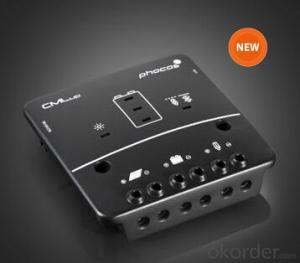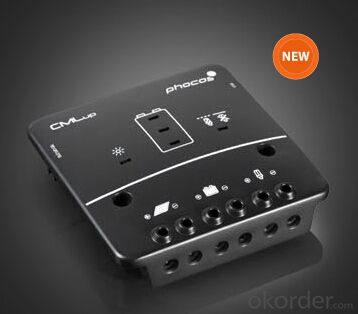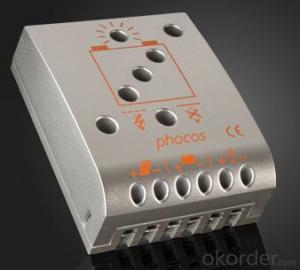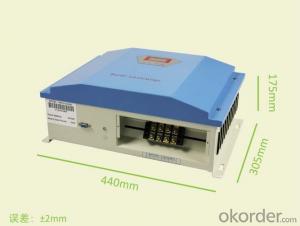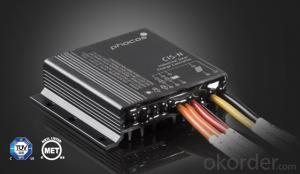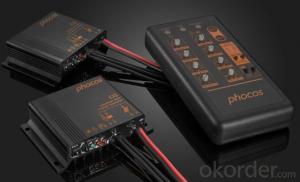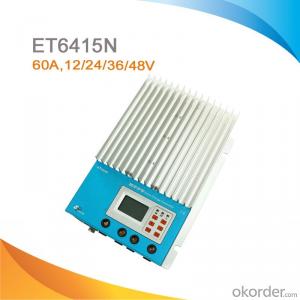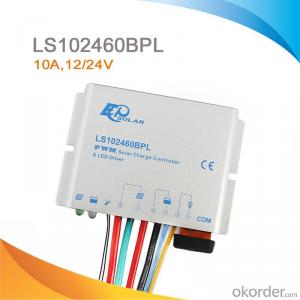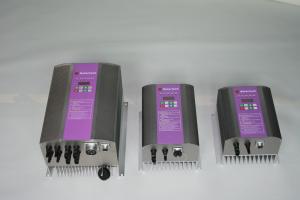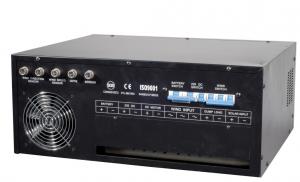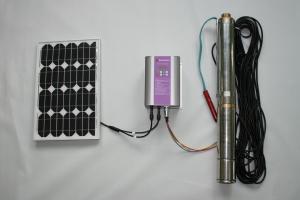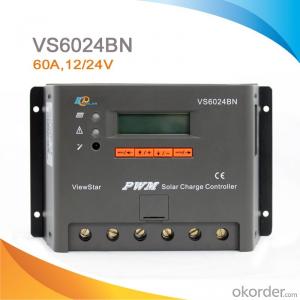50Watt CMLup Series (10 – 20 A) Solar Charge Controllers with Mobile Phone Charging Capability
- Loading Port:
- China Main Port
- Payment Terms:
- TT OR LC
- Min Order Qty:
- -
- Supply Capability:
- 10000 unit/month
OKorder Service Pledge
OKorder Financial Service
You Might Also Like
· SMD assembly, greater reliability
· New housing design
· High current rated MOSFETs
· High performance micro controller
· More intuitive LED design
· USB port for charging mobile phones or small music players
· Easily accessible terminals
· Easy mounting
· The CMLup series of charge controllers are equipped with a number of outstanding features such as a status display, alarm, and safety functions.
· The temperature-compensated, four-stage PWM charging algorithm
· (float-main-boost-equalization) is adjustable for sealed and vented lead-acid batteries.
· The CMLup charge controller also allows either a SOC or voltage-controlled low-voltage disconnect.
· Battery status is clearly indicated by three LEDs. An acoustic alarm warns about an impending low-voltage disconnect (LVD).
- Q: Can a solar controller be used with a solar-powered spa or wellness center?
- Yes, a solar controller can be used with a solar-powered spa or wellness center. A solar controller helps regulate and optimize the charging and discharging of batteries in a solar system, ensuring the efficient use of solar energy. It can be used to monitor and control the solar panels, battery banks, and other components of a solar-powered system in a spa or wellness center, providing reliable and sustainable power for various equipment and facilities.
- Q: What is the role of a solar controller in preventing damage to the solar panels from overvoltage conditions?
- The role of a solar controller in preventing damage to the solar panels from overvoltage conditions is to regulate and control the amount of voltage and current flowing from the solar panels to the batteries or grid. It ensures that the voltage stays within safe limits by monitoring the charging process and preventing overcharging. By effectively managing the flow of electricity, the solar controller protects the solar panels from potential damage caused by excessive voltage and helps maximize their lifespan and efficiency.
- Q: What is the purpose of the battery deep discharge protection feature on a solar controller?
- The purpose of the battery deep discharge protection feature on a solar controller is to prevent the battery from being discharged below a safe level. This feature helps to prolong the battery's lifespan and prevent damage to the battery cells. It also ensures that there is always enough charge remaining in the battery to power the connected devices or appliances.
- Q: What is the typical warranty period for a solar controller?
- The warranty period for a solar controller can differ based on the brand and model, but most reputable manufacturers provide warranties lasting from 1 to 5 years. Certain high-quality controllers may even offer extended warranties of up to 10 years. Prior to buying a solar controller, it is crucial to thoroughly review the manufacturer's warranty terms and conditions to ensure they align with your unique requirements and expectations.
- Q: Can a solar controller be used with solar-powered indoor government buildings?
- Solar-powered indoor government buildings can effectively utilize a solar controller. Also referred to as a charge controller, a solar controller plays a crucial role in a solar power system. Its main function is to regulate the flow of electricity between solar panels and batteries. This ensures that the batteries are efficiently charged and prevents any damage caused by overcharging. To generate electricity, solar panels in these buildings harness sunlight. This electricity powers various devices and systems within the building. In order to manage the charging process of the batteries that store this solar energy, a solar controller becomes necessary. By connecting the solar panels to the solar controller and then to the batteries, the solar controller can effectively monitor and control the charging process. This maximizes battery efficiency and lifespan. Furthermore, solar controllers often offer additional beneficial features, including temperature compensation, load control, and battery protection. These features are particularly important for indoor government buildings as they optimize the performance of the solar power system and ensure a reliable and sustainable power supply. Therefore, it is highly advisable to incorporate a solar controller in conjunction with solar-powered indoor government buildings. This guarantees the efficient and safe operation of the solar power system.
- Q: Can a solar controller be used in RVs or caravans?
- Absolutely! RVs or caravans can definitely make use of a solar controller. It is actually strongly advised to equip these vehicles with a solar controller when incorporating solar panels. A solar controller, also referred to as a charge controller, plays a significant role in managing the electricity flow from the solar panels to the battery bank. This helps prevent overcharging and prolongs the lifespan of the batteries. Moreover, it safeguards delicate electronic devices and appliances in the RV or caravan from voltage spikes or fluctuations. By employing a solar controller, you can effectively and securely tap into solar power for all your vehicle's electrical requirements while on the move or during camping excursions.
- Q: What is the maximum power output a solar controller can handle?
- The maximum power output that a solar controller can handle depends on its specifications and capabilities. It can vary from controller to controller, but typically ranges from around 10 to 60 amps, allowing for a maximum power output of 120 to 1440 watts, respectively. However, it is important to refer to the specific specifications of the solar controller in question for an accurate determination of its maximum power handling capacity.
- Q: What is the maximum battery voltage for a solar controller?
- The maximum battery voltage for a solar controller typically depends on the specific model and manufacturer. However, most solar controllers are designed to work with battery systems that have a maximum voltage of 12 volts, 24 volts, or 48 volts. It is important to consult the specifications and guidelines provided by the manufacturer to ensure compatibility and avoid any damage to the controller or battery system.
- Q: Can a solar controller be used with solar-powered disaster response equipment?
- Yes, a solar controller can be used with solar-powered disaster response equipment. A solar controller is an essential component in a solar power system as it regulates the charging and discharging of batteries. It ensures that the batteries are charged efficiently and protects them from overcharging or discharging. Therefore, it is necessary to have a solar controller to manage the power supply in disaster response equipment that relies on solar energy.
- Q: What are the advantages and disadvantages of an MPPT solar controller?
- Advantages of an MPPT (Maximum Power Point Tracking) solar controller: 1. Increased Efficiency: MPPT controllers can improve the overall efficiency of a solar system by up to 30%. They track the maximum power point of the solar panels and adjust the voltage and current to ensure that the panels are operating at their optimal efficiency, even under varying weather conditions. 2. Better Performance in Low Light Conditions: MPPT controllers are designed to extract maximum power from the solar panels, even in low light conditions. This means that they can generate electricity even when the sunlight is not at its peak, making them ideal for areas with frequent cloud cover or shading. 3. Compatibility with Different Solar Panel Configurations: MPPT controllers can be used with a wide range of solar panel configurations, including both high and low voltage panels. This makes them highly versatile and suitable for various system setups. 4. Ability to Charge Different Battery Types: MPPT controllers are capable of charging different types of batteries, such as lead-acid, lithium-ion, or gel batteries. They have built-in algorithms that optimize the charging process for each specific battery type, ensuring maximum battery life and performance. Disadvantages of an MPPT solar controller: 1. Higher Cost: MPPT controllers are generally more expensive compared to PWM (Pulse Width Modulation) controllers, which are a simpler and cheaper alternative. The additional features and advanced technology of MPPT controllers contribute to their higher price point. 2. Complex Installation and Setup: MPPT controllers require more complex installation and setup compared to PWM controllers. They often require additional wiring and configurations to connect the solar panels, batteries, and load. This may require professional assistance or a good understanding of electrical systems. 3. Increased Maintenance Requirements: MPPT controllers are more sophisticated devices, and as such, they may require more maintenance compared to PWM controllers. Regular monitoring and occasional firmware updates may be necessary to ensure optimal performance. 4. Potential for Overheating: MPPT controllers can generate more heat during operation due to their advanced circuitry. This heat needs to be dissipated effectively to prevent damage to the controller or reduce its lifespan. Adequate ventilation and proper installation are essential to avoid overheating issues. Overall, the advantages of an MPPT solar controller, such as increased efficiency, better performance in low light conditions, compatibility with different panel configurations, and the ability to charge various battery types, often outweigh the disadvantages. However, the higher cost, complex installation, increased maintenance requirements, and potential for overheating should be considered when making a decision.
Send your message to us
50Watt CMLup Series (10 – 20 A) Solar Charge Controllers with Mobile Phone Charging Capability
- Loading Port:
- China Main Port
- Payment Terms:
- TT OR LC
- Min Order Qty:
- -
- Supply Capability:
- 10000 unit/month
OKorder Service Pledge
OKorder Financial Service
Similar products
Hot products
Hot Searches
Related keywords
